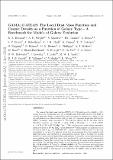GAMA/H-ATLAS : the local dust mass function and cosmic density as a function of galaxy type-A benchmark for models of galaxy evolution
Abstract
We present the dust mass function (DMF) of 15,750 galaxies with redshift z < 0.1, drawn from the overlapping area of the GAMA and H-ATLAS surveys. The DMF is derived using the density corrected Vmax method, where we estimate Vmax using: (i) the normal photometric selection limit (pVmax) and (ii) a bivariate brightness distribution (BBD) technique, which accounts for two selection effects. We fit the data with a Schechter function, and find M∗ = (4.65 ± 0.18) × 107 h270 M⊙, α = (−1.22 ± 0.01), φ∗ = (6.26 ± 0.28) × 10−3 h370 Mpc−3 dex−1. The resulting dust mass density parameter integrated down to 104 M⊙ is Ωd = (1.11 ± 0.02) × 10−6 which implies the mass fraction of baryons in dust is fmb = (2.40±0.04) ×10−5; cosmic variance adds an extra 7-17 per cent uncertainty to the quoted statistical errors. Our measurements have fewer galaxies with high dust mass than predicted by semi-analytic models. This is because the models include too much dust in high stellar mass galaxies. Conversely, our measurements find more galaxies with high dust mass than predicted by hydrodynamical cosmological simulations. This is likely to be from the long timescales for grain growth assumed in the models. We calculate DMFs split by galaxy type and find dust mass densities of Ωd = (0.88 ± 0.03) × 10−6 and Ωd = (0.060 ± 0.005) × 10−6 for late-types and early-types respectively. Comparing to the equivalent galaxy stellar mass functions (GSMF) we find that the DMF for late-types is well matched by the GMSF scaled by (8.07 ± 0.35) × 10−4.
Citation
Beeston , R A , Wright , A H , Maddox , S , Gomez , H L , Dunne , L , Driver , S P , Robotham , A , Clark , C J R , Vinsen , K , Takeuchi , T T , Popping , G , Bourne , N , Bremer , M N , Phillipps , S , Moffett , A J , Baes , M , Brough , S , Vis , P D , Eales , S A , Holwerda , B W , Loveday , J , Smith , M W L , Smith , D J B , Vlahakis , C & Wang , L 2018 , ' GAMA/ H -ATLAS : the local dust mass function and cosmic density as a function of galaxy type-A benchmark for models of galaxy evolution ' , Monthly Notices of the Royal Astronomical Society , vol. 479 , no. 1 , pp. 1077–1099 . https://doi.org/10.1093/mnras/sty1460
Publication
Monthly Notices of the Royal Astronomical Society
Status
Peer reviewed
ISSN
0035-8711Type
Journal article
Description
RAB, HLG, SJM, and LD acknowledge support from the European Research Council (ERC) in the form of Consolidator Grant CosmicDust (ERC-2014-CoG-647939, PI HL Gomez). LD, SJM and NB acknowledge support from European Research Council Advanced Investigator Grant COSMICISM, 321302. CJRC acknowledges support from the ERC in the form of the 7th framework programme (FP7) grant DustPedia (PI Jon Davies, proposal 606824).Collections
Items in the St Andrews Research Repository are protected by copyright, with all rights reserved, unless otherwise indicated.

